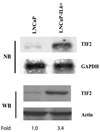Interleukin-6 increases prostate cancer cells resistance to bicalutamide via TIF2
- PMID: 19240160
- PMCID: PMC3041173
- DOI: 10.1158/1535-7163.MCT-08-0823
Interleukin-6 increases prostate cancer cells resistance to bicalutamide via TIF2
Abstract
The standard treatment for advanced, androgen-responsive prostate cancer is androgen deprivation therapy with or without a nonsteroidal antiandrogen, such as bicalutamide. Although maximal androgen blockade exhibits favorable responses in the majority of patients, prostate cancer eventually progresses to an androgen-refractory stage. The mechanism underlying bicalutamide resistance in the course of prostate cancer progression is incompletely understood. However, interleukin-6 (IL-6) plays a critical role in the development and progression of CRPC. Herein, we explored an association between IL-6 and bicalutamide resistance. To study this, series of lower and higher passages of LNCaP cell sublines generated by long-term exposure to IL-6 were used. The cells from higher passages of LNCaP treated with IL-6 developed resistance to bicalutamide treatment compared with parental LNCaP cells. The levels of transcriptional intermediary factor 2 (TIF2) in IL-6-treated LNCaP cells were found to be significantly higher than parental LNCaP cells. Down-regulation of TIF2 expression via short hairpin RNA in IL-6-treated LNCaP cells sensitized these cells to bicalutamide treatment, whereas overexpression of TIF2 in the parental LNCaP cells increased resistance to bicalutamide. Furthermore, overexpression of IL-6 attenuated bicalutamide-mediated blockage of androgen-induced androgen receptor nuclear translocation and recruitment. These results show that overexpression of IL-6 increases the resistance of prostate cancer cells to bicalutamide via TIF2. Overexpression of IL-6 not only plays an important role in prostate cancer progression but also contributes to bicalutamide resistance. Our studies suggest that bicalutamide-IL-6-targeted adjunctive therapy may lead to a more effective intervention than bicalutamide alone.
Conflict of interest statement
No potential conflicts of interest were disclosed.
Figures




Similar articles
-
Switch from antagonist to agonist of the androgen receptor bicalutamide is associated with prostate tumour progression in a new model system.Br J Cancer. 1999 Sep;81(2):242-51. doi: 10.1038/sj.bjc.6690684. Br J Cancer. 1999. PMID: 10496349 Free PMC article.
-
Short hairpin RNA library-based functional screening identified ribosomal protein L31 that modulates prostate cancer cell growth via p53 pathway.PLoS One. 2014 Oct 6;9(10):e108743. doi: 10.1371/journal.pone.0108743. eCollection 2014. PLoS One. 2014. PMID: 25285958 Free PMC article.
-
Establishment and characterization of an androgen receptor-dependent, androgen-independent human prostate cancer cell line, LNCaP-CS10.Prostate. 2010 Apr 1;70(5):457-66. doi: 10.1002/pros.21079. Prostate. 2010. PMID: 19902465
-
Activity of androgen receptor antagonist bicalutamide in prostate cancer cells is independent of NCoR and SMRT corepressors.Cancer Res. 2007 Sep 1;67(17):8388-95. doi: 10.1158/0008-5472.CAN-07-0617. Cancer Res. 2007. PMID: 17804755
-
Molecular mechanisms of castration-resistant prostate cancer progression.Future Oncol. 2009 Nov;5(9):1403-13. doi: 10.2217/fon.09.117. Future Oncol. 2009. PMID: 19903068 Free PMC article. Review.
Cited by
-
Interleukin-6 regulates androgen synthesis in prostate cancer cells.Clin Cancer Res. 2009 Aug 1;15(15):4815-22. doi: 10.1158/1078-0432.CCR-09-0640. Epub 2009 Jul 28. Clin Cancer Res. 2009. PMID: 19638459 Free PMC article.
-
IL6 sensitizes prostate cancer to the antiproliferative effect of IFNα2 through IRF9.Endocr Relat Cancer. 2013 Aug 23;20(5):677-89. doi: 10.1530/ERC-13-0222. Print 2013 Oct. Endocr Relat Cancer. 2013. PMID: 23913484 Free PMC article.
-
Androgen receptor co-activators in the regulation of cellular events in prostate cancer.World J Urol. 2012 Jun;30(3):297-302. doi: 10.1007/s00345-011-0797-6. Epub 2011 Nov 22. World J Urol. 2012. PMID: 22105110 Review.
-
Mechanisms of persistent activation of the androgen receptor in CRPC: recent advances and future perspectives.World J Urol. 2012 Jun;30(3):287-95. doi: 10.1007/s00345-011-0771-3. Epub 2011 Oct 19. World J Urol. 2012. PMID: 22009116 Review.
-
Lycopene enhances docetaxel's effect in castration-resistant prostate cancer associated with insulin-like growth factor I receptor levels.Neoplasia. 2011 Feb;13(2):108-19. doi: 10.1593/neo.101092. Neoplasia. 2011. PMID: 21403837 Free PMC article.
References
-
- Kolvenbag GJ, Furr BJ. Relative potency of bicalutamide (Casodex) and flutamide (Eulexin) Urology. 1999;54:194–197. - PubMed
-
- Kolvenbag GJ, Blackledge GR. Worldwide activity and safety of bicalutamide: a summary review. Urology. 1996;47:70–79. discussion 80-4. - PubMed
-
- Blackledge G, Kolvenbag G, Nash A. Bicalutamide: a new antiandrogen for use in combination with castration for patients with advanced prostate cancer. Anti Cancer Drugs. 1996;7:27–34. - PubMed
-
- Scher HI, Steineck G, Kelly WK. Hormone-refractory (D3) prostate cancer: refining the concept. Urology. 1995;46:142–148. - PubMed
Publication types
MeSH terms
Substances
Grants and funding
LinkOut - more resources
Full Text Sources
Other Literature Sources
Medical

